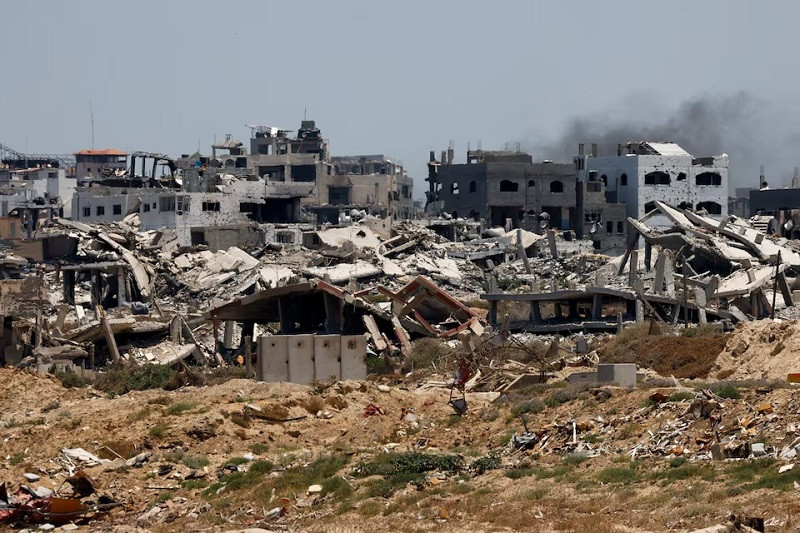
CAIRO:
Israeli forces pounded several areas across Gaza on Wednesday, and residents reported fierce fighting overnight in Rafah in the south of the Palestinian enclave.
Residents said fighting intensified in the Tel Al-Sultan neighbourhood in western Rafah, where tanks were also trying to force their way north amid heavy clashes. The armed wings of Hamas and the Islamic Jihad said fighters attacked Israeli forces with anti-tank rockets and mortar bombs.
Since early May, ground fighting has focused on Rafah, abutting Egypt on Gaza’s southern edge, where around half of the enclave’s 2.3 million people had been sheltering after fleeing other areas. Most have since had to flee again.
Israel says that it is close to destroying the last remaining Hamas battalions in Rafah, after which it will move to smaller scale operations in the enclave.
Medics said two Palestinians were killed in one Israeli missile strike in Rafah.
Read also: Israeli airstrikes in Gaza City kill at least 24
The Israeli military said in a statement its forces killed a Hamas fighter who had been involved in the smuggling of weapons through the border between Rafah and Egypt. It said jets struck dozens of resistance targets in Rafah overnight, including fighters, military structures and tunnel shafts.
Later on Wednesday, an Israeli strike killed three Palestinians and wounded others near the northern Jabalia camp, one of the Gaza Strip’s eight historic refugee camps, medics said.
Residents and Hamas media said the casualties were among a group of people who gathered outside a store to get an internet signal to communicate with relatives elsewhere in the enclave.
In Nuseirat camp in the central Gaza Strip, tank shells struck an apartment, killing at least five people and wounding others, medics said.
The Israeli military had no immediate comment.
Hostage deal plea
Israel’s ground and air campaign in Gaza was triggered when Hamas-led fighters stormed into southern Israel on Oct. 7, killing around 1,200 people and seizing more than 250 hostages, according to Israeli tallies.
The Israeli offensive in retaliation has so far killed 37,658 people, of them 60 in the past 24 hours, the Gaza health ministry said on Tuesday, and has left the tiny, heavily built-up Gaza Strip in ruins.
The Gaza health ministry does not distinguish between combatants and non-combatants, but officials say most those killed have been civilians. Israel has lost 314 soldiers in Gaza and says at least a third of the Palestinian dead are fighters.
More than eight months into the war, international mediation backed by the US has failed to yield a ceasefire agreement. Hamas says any deal must bring an end to the war and full Israeli withdrawal from Gaza, while Israel says it will accept only temporary pauses in fighting until Hamas is eradicated.
Orly Gilboa, whose 20-year-old daughter Daniela is being held hostage in Gaza, called on Israeli leaders to accept the deal and on the international community to pressure Hamas to do the same.
“The deal is there to be signed and implemented. I’m asking my own government to stand behind its own proposal, to be brave as our girls are, to save them, to save us. Time is running out,” she told a press conference in Tel Aviv.
Severe food shortage
In the northern Gaza Strip, Palestinians complained of a severe lack of food and soaring prices, and health officials said thousands of children were suffering from malnutrition that has already killed at least 30 since Oct. 7.
“There is only flour and canned food, there is nothing else to eat, no vegetables, no meat, and no milk,” said Abu Mustafa, who lives in Gaza City, with his family.
Their house was struck in the past week by an Israeli tank, that destroyed most of the upper floor.
“Apart from the bombing, there is another Israeli war taking place in northern Gaza, starvation. People meet in the street and many can’t recognise one another because of weight loss and older looks,” Abu Mustafa told Reuters via a chat app.
1719420076-1/Destroyed-buildings-Gaza-(2)1719420076-1.jpeg)
Destroyed buildings are pictured in Gaza, amid the ongoing conflict between Israel and Hamas, as seen near the Gaza coast. PHOTO: REUTERS
Gaza remains at high risk of famine, though delivery of some aid has limited the projected spread of extreme hunger in northern areas, a global monitor said on Tuesday.
More than 495,000 people across the Gaza Strip are facing the most severe, or “catastrophic”, level of food insecurity, according to an update from the Integrated Food Security Phase Classification (IPC) a global partnership used by the United Nations and aid agencies.
Wrapping up a visit to Washington, Israeli Defence Minister Yoav Gallant said Israel was fighting against Hamas, not the people of Gaza.
“We are committed, and I am personally committed, to facilitating the delivery of essential humanitarian aid to Gaza. We only fight those who seek to harm us,” Gallant said in a video statement.

